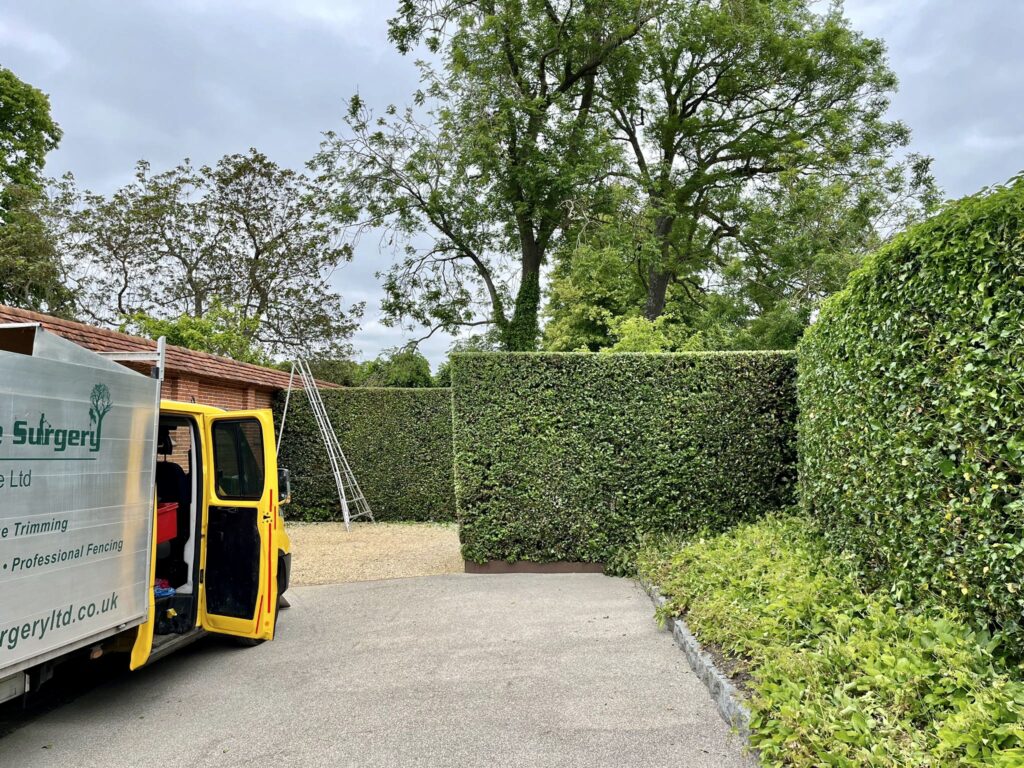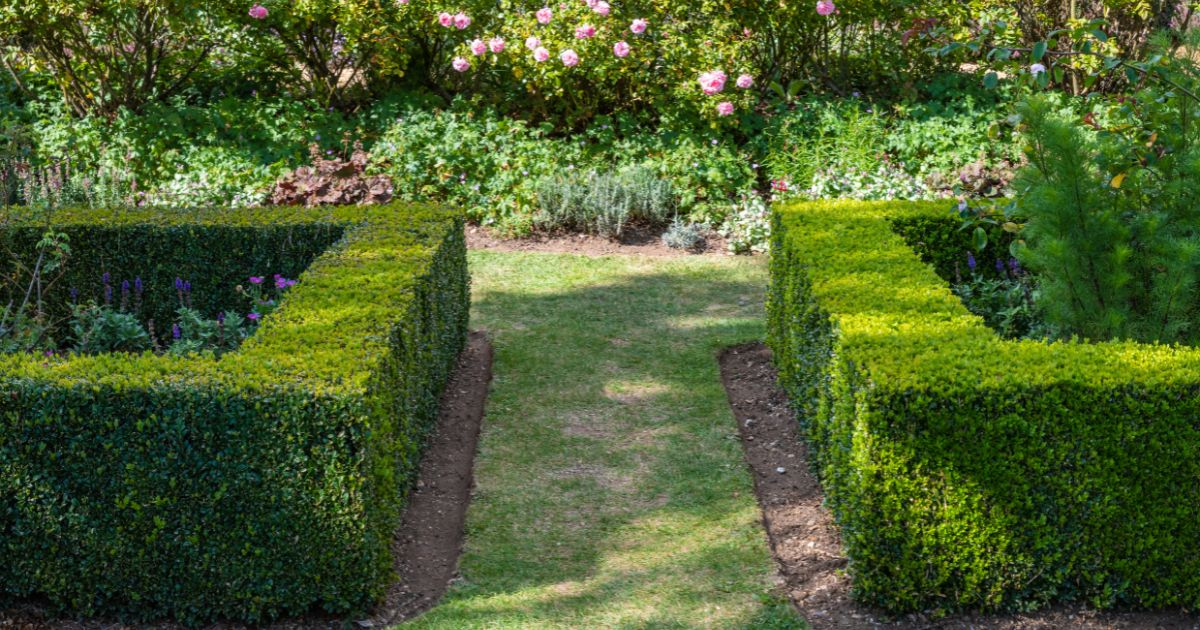Trimming Your Box Hedge
Box hedges are a classic and elegant addition to any garden, providing structure, privacy, and a touch of formality.
However, to maintain their neat appearance, regular trimming is essential. Knowing when to trim your box hedge can mean the difference between a lush, vibrant hedge and one that appears overgrown or misshapen. But, when is the best time to do so?
The ideal time to trim a box hedge is during the growing season, which typically runs from late spring to early autumn.
This is when the plant is actively growing and will recover quickly from pruning. Avoid trimming during periods of extreme heat or cold, as this can put stress on the plant and slow down its growth.
In this article, we’ll explore the best times to trim your box hedge and provide some tips for keeping it looking its best.
Let’s dive in.

If you need help pruning your tree, get in touch with the experts at Evolution Tree Surgery. We’re on hand to help with all aspects of hedge pruning, tree pruning, crown reduction, crown lifting, and crown thinning in Newbury, Berkshire and the surrounding areas.
If you’d like a free quote, call us at 07917 195806 or complete our online enquiry form.
What is a Box Hedge?
A box hedge is a landscaping feature formed by planting boxwood shrubs (Buxus sempervirens) in a close row and trimming them regularly to create a dense, uniform shape.
The buxus sempervirens is native to central Europe and is a popular choice among gardeners for its versatility as a boundary or a standalone shrub. Box hedges are part of a large family of around 70 boxwood plant varieties.
Box hedges can be grown in a variety of soil types, but prefer well-draining soil that is rich in organic matter. They also prefer a slightly acidic soil pH. Box hedges can be grown in full sun to partial shade, but may require more frequent watering in full sun.
When it comes to pruning box hedges, timing is important. The best time to prune box hedges is in late spring or early summer, after the new growth has emerged. This allows the hedge to recover before the colder months set in. They can also be lightly pruned in late summer to maintain their shape.
Box hedges are susceptible to a few different pests and diseases, including box blight and boxwood leafminer. Regular inspection and treatment can help prevent these issues from becoming a problem.
Here’s a breakdown of its key characteristics:
- Plant: Made from boxwood shrubs, known for their small, glossy green leaves.
- Evergreen: Provides year-round interest and privacy as it retains its leaves throughout the winter.
- Versatility: Can be trimmed into various shapes, from low borders to tall privacy screens, or even sculpted into intricate topiary designs.
- Formal Touch: Adds a classic and elegant look to any garden, perfect for creating defined borders or pathways.
- Maintenance: Requires regular trimming to maintain its desired shape, typically in spring and summer.
Box hedges are a popular choice for gardeners due to their versatility, low maintenance (once established), and ability to thrive in various conditions (though not ideal for very wet or windy areas).
When to Trim Box Hedge
The best time to trim your box hedge depends on a few factors but generally falls within the growing season, which is typically spring to early autumn.
Here’s a breakdown of the ideal timing:
- Late May/Early June: This is the prime time for the first trim of the year. After the threat of frost has passed, trimming helps shape the hedge and encourages new, healthy growth.
- August/September: After the initial spring growth, a light trim in late summer helps maintain the hedge’s shape and removes any wayward branches. This also prepares the hedge for the coming winter.
Additional Considerations:
- Fast-Growing Hedges: If your box hedge grows quickly, you might consider an additional light trim in July, especially if you prefer a very formal look.
- Hedge Maturity: Mature hedges can handle a more significant trim in late spring, potentially even cutting back by 15-30cm (6-12in) to rejuvenate overgrown areas.
- Desired Shape: More intricate shapes like spirals or topiaries require more frequent trimming, potentially every 4-6 weeks throughout the growing season, to maintain their definition.
Remember: Avoid trimming on hot, sunny days as it can scorch the leaves. Opt for a cool, cloudy day for optimal results.
Why Should You Trim Your Box Hedge?
Box hedges are a beautiful addition to any garden, offering year-round greenery and a touch of formal elegance. But their beauty isn’t the only reason to keep them trimmed. Here’s a closer look at the benefits of regular box hedge maintenance:
- Maintains Shape & Structure: Trimming keeps your hedge looking neat and tidy, preventing it from becoming overgrown and losing its defined form.
- Encourages Growth: Regular trimming stimulates new growth throughout the hedge, resulting in a denser and healthier plant.
- Boosts Air Circulation: Proper trimming allows for better airflow within the hedge, which helps prevent the spread of diseases like box blight.
- Maximises Light Penetration: A well-trimmed hedge allows sunlight to reach all parts of the plant, promoting healthy growth throughout.
- Controls Size & Spread: Trimming keeps your hedge at a manageable size, preventing it from encroaching on walkways or neighboring properties.
- Enhances Aesthetics: A well-maintained box hedge adds a polished look to your garden, creating a sense of order and visual appeal.

Essential Tools to Prune Your Boxwood
Here are some essential tools for trimming your hedge:
- Safety goggles: Safety goggles will protect your eyes from any flying debris while trimming the hedge.
- Secateurs: These handheld pruning shears are perfect for trimming thinner branches and making precise cuts.
- Shears: Larger shears are ideal for shaping and trimming larger branches and foliage.
- Hedge trimmer: Electric or manual hedge trimmers are essential for trimming a box hedge. Electric trimmers are more efficient for larger hedges, while manual trimmers are better for smaller hedges and precision work.
Choose tools that are sharp and in good condition to prevent damage to the plants.
Step-by-Step Guide to Trimming Box Hedge
Here is a guide to trimming your box hedge:
- Assess your hedge before trimming to determine the desired height and shape.
- Use a hedge trimmer or shears to remove any dead or diseased branches.
- Start trimming from the bottom of the hedge, working your way up in small sections.
- Use smooth, sweeping motions to create an even and straight cut.
- Step back periodically to assess your progress and make any necessary adjustments.
- Prune any remaining branches or foliage to achieve the desired shape.
- Dispose of the trimmings properly.
Tips for Trimming Your Box Hedge
Fertiliser for Your Shrub
The best time to fertilise box hedges depends on whether they are in containers or planted in the ground:
- Box Hedges in the Ground: For box hedges growing directly in your garden soil, apply a balanced fertiliser in the autumn (around October). This allows the nutrients to be absorbed by the roots over winter and promote healthy growth in the following spring.
- Box Hedges in Containers: Box plants growing in pots require regular feeding due to the limited nutrients in potting mix. Use a liquid seaweed feed or a gentle, slow-release fertiliser every month or so during the summer (April to September).
How to Help Your Box Topiary Avoid Fungal Diseases
The best way to prevent fungal infections in your box plant is to focus on the right care. Boxwood, like any type of plant, thrives with proper care that keeps it healthy and resistant to disease.
Here are some key things to remember:
- Moisture control: Avoid creating a breeding ground for fungus by ensuring proper drainage in the soil. Overwatering can be detrimental, so water only when the top inch of soil feels dry.
- Air circulation: Good air circulation around the box topiary helps prevent moisture build-up, which can encourage fungal diseases. Avoid planting box shrubs too close together or to other plants that might crowd them.
- Pruning: Regular pruning throughout the growing season (typically spring and summer) promotes good air circulation within the plant and removes any diseased branches. Aim for clean cuts with sharp shears and dispose of clippings properly to avoid spreading any potential fungus.
Avoid Trimming in Extreme Heat or Cold
It’s best to avoid trimming box hedges during periods of extreme heat or cold. Trimming in the hot summer months can stress the plants, making them susceptible to disease and pest infestations.
Similarly, trimming in the depths of winter can expose the inner parts of the hedge to harsh weather conditions, potentially causing damage or die-back.
Regular Maintenance Trimming
While the ideal trimming season is late spring or early summer, box hedges typically require regular maintenance trimming throughout the growing season.
A light trimming every 6-8 weeks can help maintain the desired shape and prevent the hedge from becoming overgrown or unruly.
Shaping and Rejuvenation Pruning
In addition to regular trimming, box hedges may require more extensive shaping or rejuvenation pruning from time to time. This type of pruning is best done in late winter or early spring before new growth emerges.
Shaping pruning helps restore the desired shape and size of the hedge, while rejuvenation pruning involves cutting the hedge back hard to encourage new growth and rejuvenate an overgrown or neglected hedge.
Tools and Techniques for Trimming
For best results, use sharp, clean pruning shears or hedge trimmers when trimming your box hedge. Make clean, angled cuts to encourage healthy growth and prevent damage to the plants.
When shaping or rejuvenating the hedge, consider using a string or guide to ensure a consistent, even shape.

Need Help Trimming Your Box Hedge?
While box hedges require very little pruning to maintain their shape, it is important to ensure that the pruning is done correctly and at the right time of year to promote healthy growth and prevent damage to the tree.
By hiring a professional tree surgeon, you can ensure that your hedges receive the care they need to thrive.
At Evolution Tree Surgery, we offer hedge pruning for residential and commercial customers in Newbury and the surrounding areas in Berkshire.
For a FREE hedge pruning quote, call Evolution Tree Surgery in Newbury at 07917 195806 .
Frequently Asked Questions
How often should I trim my box hedge to maintain shape?
To maintain the shape of a box hedge, it is advisable to trim it once or twice a year. The exact frequency depends on the desired height and growth rate of the hedge. Regular trimming helps promote new growth and prevents the hedge from becoming overgrown.
Can I trim my box hedge in hot weather?
Trimming a box hedge in hot weather, especially in full sun is not recommended. The heat and direct sunlight can cause stress to the recently trimmed branches and leaves, increasing the risk of damage and sunburn. It is best to wait for a cooler, cloudy day to trim the hedge.
What should I do with clippings after trimming?
After trimming a box hedge, the clippings can be used for composting. Box hedge clippings are rich in nitrogen and can provide valuable nutrients to the compost. Use the compost as a natural fertiliser for other plants in the garden. Otherwise, you can recycle the clippings with your local council collection.
How can I repair a poorly trimmed box hedge?
If a box hedge has been poorly trimmed, it is possible to repair it with proper pruning techniques. Start by removing any damaged or diseased branches and allow the hedge to recover. Trim the hedge gradually to achieve the desired height and shape, ensuring that the new growth is healthy and balanced.
What month do you trim Buxus?
Buxus, also known as boxwood, is typically trimmed in late spring (around April) for the first time of the year, and then again in late summer (around August/September).
How to trim a box hedge straight?
For a straight and even trim on your box hedge, using a hedge trimmer is a good option. You can also achieve straight lines by using a taut string as a guide while trimming with shears.
When is the best time to trim a box hedge?
The best time to trim a box hedge depends on what you’re aiming for. For the overall health of the plant, it’s generally recommended to do your main trimming in late spring (April) after the frost risk has passed. This encourages new growth and keeps the hedge in shape. You can then do a lighter trim in late summer (August/September) to maintain that shape.
When should you not cut a box hedge?
Avoid cutting your box hedge during cold winter temperatures or during hot, dry periods. Cold temperatures can stress the plant, while hot sun can scorch the leaves. Also, be mindful of the box tree moth caterpillar, which feeds on box plants. If you suspect an infestation, avoid trimming as it can spread the caterpillars.
Related Guides & Advice:
- Hedge Removal Made Easy: Step-by-Step
- How to Prune an Apple Tree
- Best Time to Cut Conifers for Healthy Growth
- How Much Does Hedge Trimming Cost?
- How to Prune a Silver Birch Tree
- When to Prune a Magnolia Tree
- How Much Does Tree Surgery Cost?
- What is Tree Felling?
- What is a Tree Surgeon?
- When is the Best Time to Cut Trees Back
- How to Choose a Tree Surgeon

